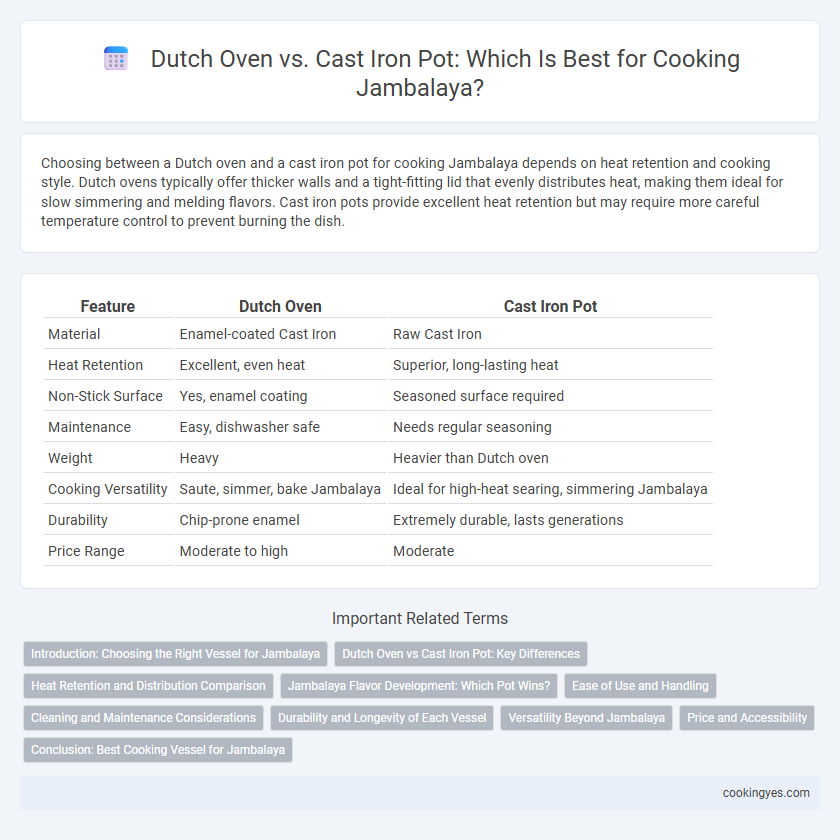Choosing between a Dutch oven and a cast iron pot for cooking Jambalaya depends on heat retention and cooking style. Dutch ovens typically offer thicker walls and a tight-fitting lid that evenly distributes heat, making them ideal for slow simmering and melding flavors. Cast iron pots provide excellent heat retention but may require more careful temperature control to prevent burning the dish.
Table of Comparison
| Feature | Dutch Oven | Cast Iron Pot |
|---|---|---|
| Material | Enamel-coated Cast Iron | Raw Cast Iron |
| Heat Retention | Excellent, even heat | Superior, long-lasting heat |
| Non-Stick Surface | Yes, enamel coating | Seasoned surface required |
| Maintenance | Easy, dishwasher safe | Needs regular seasoning |
| Weight | Heavy | Heavier than Dutch oven |
| Cooking Versatility | Saute, simmer, bake Jambalaya | Ideal for high-heat searing, simmering Jambalaya |
| Durability | Chip-prone enamel | Extremely durable, lasts generations |
| Price Range | Moderate to high | Moderate |
Introduction: Choosing the Right Vessel for Jambalaya
The Dutch oven and cast iron pot are essential cooking vessels for authentic jambalaya, each offering superior heat retention and even cooking. Dutch ovens, often heavier with a tight-fitting lid, excel in slow simmering to meld flavors, while cast iron pots provide excellent searing capabilities and versatility. Selecting the right vessel depends on balancing heat distribution and moisture control to achieve the perfect jambalaya texture and flavor.
Dutch Oven vs Cast Iron Pot: Key Differences
A Dutch oven features thicker walls and a tight-fitting lid, providing superior heat retention and even cooking ideal for slow-simmered jambalaya. Cast iron pots, while durable and excellent for high-heat searing, often lack the precision heat distribution and moisture sealing that a Dutch oven offers. Choosing a Dutch oven enhances flavor development and texture in jambalaya by maintaining consistent temperatures and trapping steam effectively.
Heat Retention and Distribution Comparison
Cast iron pots excel in heat retention, maintaining a consistent temperature ideal for the slow simmering required in Jambalaya, while Dutch ovens, often made from cast iron with an enamel coating, provide even heat distribution and prevent hot spots that can cause uneven cooking. The heavy lid of a Dutch oven seals in moisture effectively, enhancing flavor development and texture in the dish. Both vessels are durable, but the choice depends on whether you prioritize the superior heat retention of bare cast iron or the easier maintenance and even heating of an enameled Dutch oven.
Jambalaya Flavor Development: Which Pot Wins?
The Dutch oven's thick, heavy lid traps steam and maintains steady heat, promoting deep caramelization and flavor melding essential for authentic jambalaya. Cast iron pots, while excellent at heat retention and creating a desirable fond, often lack the tight-sealing lid that enhances moisture circulation and flavor concentration. For optimal jambalaya flavor development, the Dutch oven typically outperforms the cast iron pot by fostering a more balanced and intensified taste profile.
Ease of Use and Handling
A Dutch oven offers excellent heat retention and even cooking for jambalaya but tends to be heavier and bulkier, which can make handling more challenging, especially when transferring hot dishes. Cast iron pots, particularly those with an enameled surface, provide superior ease of use with smoother cleaning and lighter weight options, enhancing maneuverability during stirring and serving. Both vessels excel in heat distribution, but cast iron's ergonomic designs often improve user comfort and handling efficiency in busy kitchen environments.
Cleaning and Maintenance Considerations
Dutch ovens and cast iron pots require diligent cleaning to prevent rust and preserve seasoning, with both best cleaned by hand using hot water and a stiff brush without soap. Dutch ovens often feature an enamel coating that simplifies maintenance by preventing food from sticking and eliminating the need for seasoning, while traditional cast iron pots demand regular oiling after cleaning to maintain their non-stick surface. Proper drying and occasional re-seasoning are essential for cast iron cookware, whereas enameled Dutch ovens avoid these extra steps but can chip if handled roughly.
Durability and Longevity of Each Vessel
Dutch ovens and cast iron pots are prized for their exceptional durability and long lifespan, making them ideal choices for cooking jambalaya. Dutch ovens, often made from enameled cast iron, resist rust and chipping, extending their usability with minimal maintenance. Traditional cast iron pots, while requiring seasoning to prevent corrosion, develop a natural non-stick surface over time and can last for generations when properly cared for, evidencing superior longevity and reliability.
Versatility Beyond Jambalaya
Dutch ovens and cast iron pots both offer exceptional heat retention and even cooking, essential for preparing authentic jambalaya. Beyond jambalaya, these vessels excel in versatility, allowing for roasting, braising, baking, and frying with consistent temperature control. Cast iron pots, often more portable and lightweight, suit outdoor cooking, while Dutch ovens feature tight-fitting lids ideal for slow-cooked stews and soups.
Price and Accessibility
Dutch ovens and cast iron pots both offer excellent heat retention for cooking jambalaya, but cast iron pots are generally more affordable and widely accessible. Dutch ovens, often made of enameled cast iron, tend to be pricier due to their coating and brand variety, making them a premium option for many home cooks. For budget-conscious individuals or beginners, a traditional cast iron pot is a practical and cost-effective choice that still delivers authentic flavors.
Conclusion: Best Cooking Vessel for Jambalaya
The best cooking vessel for Jambalaya is a Dutch Oven due to its excellent heat retention and even distribution, which ensures the dish cooks uniformly without burning. Cast Iron Pots offer durability and high heat capacity but may develop hot spots that can cause uneven cooking. Overall, the Dutch Oven's tight-fitting lid and superior moisture retention make it ideal for achieving authentic, flavorful Jambalaya.
Dutch Oven vs Cast Iron Pot for cooking vessel Infographic

 cookingyes.com
cookingyes.com